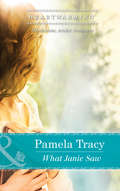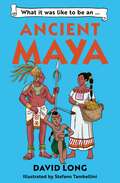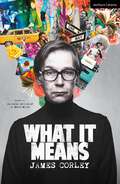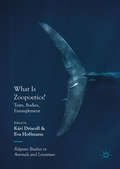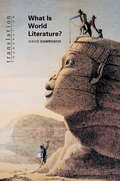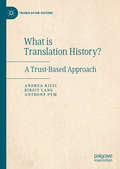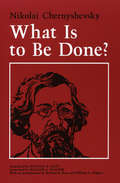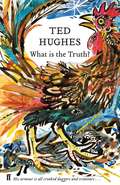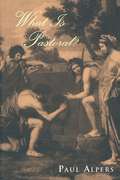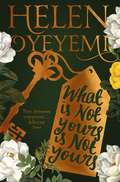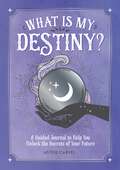- Table View
- List View
What July Knew: If you liked ELIZABETH IS MISSING, you'll LOVE this
by Emily KochTHE BIG-HEARTED BOOK EVERYONE WILL BE READING IN 2023100s of 4 and 5 STAR NETGALLEY REVIEWS AVAILABLE FOR PRE-ORDER NOW_______________________________________A moving mystery about family secrets, grief and growing upREADERS LOVE WHAT JULY KNEW:'This is possibly my favourite book of 2022''Beautifully written, and absolutely engrossing''The ending was amazing. Highly recommended''I just couldn't stop reading. I found myself as desperate as July to find out what happened to her mum''What July Knew takes you on a wild ride and does not let you go''A totally absorbing psychological drama''You'll read July's story and fall utterly in love'___________________________________Summer, 1995. July Hooper knows eighteen things about her mother. Like number thirteen: she loved dancing on the kitchen table. And number eight: she was covered in freckles. And then there's number two: she died after being hit by a car when July was small. She keeps this list hidden in a drawer away from her father. Because they're not allowed to talk about her mother. Ever. But an anonymous note slipped into July's bag on her tenth birthday is about to change everything she thinks she knows about her mum. Determined to discover what really happened to her, July begins to investigate, cycling around the neighbourhood where her family used to live. There she meets someone who might finally have the answers. July wants her family to stop lying to her, but will the truth be harder to face?
What Janie Saw (Scorpion Ridge, Arizona #2)
by Pamela TracyThe last person she wanted was the only one who could keep her safe
What It Was Like to be … (3) — WHAT IT WAS LIKE TO BE AN ANCIENT MAYA
by David Long Illustrated by Stefano TambelliniEmbark on a captivating exploration into the rise and fall of the rich and colourful Maya civilisation with Blue Peter Award-winning author David Long. Largely forgotten for centuries, the ancient Maya were incredible. Their cities across Central and South America featured astonishing pyramids and palaces, while they were also successful farmers and highly creative artists. The Maya were the first people in the Americas to learn how to read and write, and they invented things like rubber, chocolate and chewing gum. They had a deep understanding of astronomy, mathematics and timekeeping, though they also had some horrible, bloodthirsty traditions such as making human sacrifices. Find out what life as an Ancient Maya was actually like while also investigating why this mysterious civilisation was close to dying out when the region was conquered by Spanish conquistadors in the sixteenth century.
What It Was (Derek Strange And Terry Quinn Ser.)
by George PelecanosA riveting crime novel from one of the writers of THE WIRE.Washington, D.C., 1972. Derek Strange has left the police department and set up shop as a private investigator. His former partner, Frank "Hound Dog" Vaughn, is still on the force. When a young woman comes to Strange asking for his help recovering a cheap ring she claims has sentimental value, the case leads him onto Vaughn's turf, where a local drug addict's been murdered, shot point-blank in his apartment. Soon both men are on the trail of a ruthless killer: Red Fury, so called for his looks and the car his girlfriend drives, but a name that fits his personality all too well. Red Fury doesn't have a retirement plan, as Vaughn points out - he doesn't care who he has to cross, or kill, to get what he wants. As the violence escalates and the stakes get higher, Strange and Vaughn know the only way to catch their man is to do it their own way.Rich with details of place and time - the cars, the music, the clothes - and fueled by non-stop action, this is Pelecanos writing in the hard-boiled noir style that won him his earliest fans and placed him firmly in the ranks of the top crime writers in America.
What It Means When A Man Falls From The Sky: From the Winner of the Caine Prize for African Writing 2019
by Lesley Nneka Arimah'Remarkable range and exquisite prose' Ayobami Adebayo, Guardian Books of the YearA stunning collection of short stories from Caine-Prize shortlisted and Commonwealth Writer's Prize winner Lesley Nneka Arimah, WHAT IT MEANS WHEN A MAN FALLS FROM THE SKY has been described as 'luminous' (Roxane Gay), 'mesmeric' (Claire Vaye Watkins) and 'hilarious and heartbreaking' (Rowan Hisayo Buchanan). Shot through with magic and a powerful sense of yearning, this is a diverse and dazzling collection that showcases the work of a major new talent at the beginning of a stellar literary career.'When Enebeli Okwara sent his girl out in the world, he did not know what the world did to daughters'. The daughters, wives and mothers in Lesley Nneka Arimah's remarkable debut collection find themselves in extraordinary situations: a woman whose mother's ghost appears to have stepped out of a family snapshot, another who, exhausted by childlessness, resorts to fashioning a charmed infant out of human hair, a 'grief worker' with a miraculous ability to remove emotional pain - at a price. What unites them is the toughness of the world they inhabit, a world where the future is uncertain, opportunities are scant, and fortunes change quicker than the flick of a switch. Characterised by their vividness, immediacy and the author's seemingly endless ability to conjure worlds at once familiar and unsettlingly different, this collection showcases the work of an extraordinarily talented writer at the start of a brilliant career.
What it Means: Based on On Being Different by Merle Miller (Modern Plays)
by James CorleyThey say they've broken into the offices of Harper's Magazine and are staging a sit-inSeptember 1970, Harper's Magazine publish the article Homo/Hetero: The Struggle for Sexual Identity in which Joseph Epstein states "If I had the power to do so, I would wish homosexuality off the face of the earth". The Gay Activists Alliance stage a sit-in at the Harper's office. But there are many ways to protest. In his Glass House, hidden in the woods outside Brewster New York, Merle Miller - acclaimed journalist and former editor of Harper's Magazine - sits at his desk and begins to write. An emotional one-person voyage through history - some personal, some not - What It Means speaks directly to audiences about the importance of standing up for what you believe in, accepting the validity of one's own voice and taking a courageous step onto the platform that is offered to you. This edition was published to coincide with the world premiere stage production at Wilton's Music Hall in October 2023, from The Lot Productions.
What it Means: Based on On Being Different by Merle Miller (Modern Plays)
by James CorleyThey say they've broken into the offices of Harper's Magazine and are staging a sit-inSeptember 1970, Harper's Magazine publish the article Homo/Hetero: The Struggle for Sexual Identity in which Joseph Epstein states "If I had the power to do so, I would wish homosexuality off the face of the earth". The Gay Activists Alliance stage a sit-in at the Harper's office. But there are many ways to protest. In his Glass House, hidden in the woods outside Brewster New York, Merle Miller - acclaimed journalist and former editor of Harper's Magazine - sits at his desk and begins to write. An emotional one-person voyage through history - some personal, some not - What It Means speaks directly to audiences about the importance of standing up for what you believe in, accepting the validity of one's own voice and taking a courageous step onto the platform that is offered to you. This edition was published to coincide with the world premiere stage production at Wilton's Music Hall in October 2023, from The Lot Productions.
What Is Zoopoetics?: Texts, Bodies, Entanglement (Palgrave Studies in Animals and Literature)
by Kári Driscoll Eva HoffmannThis book brings together essays dealing with the question of zoopoetics both as an object of study—i.e. texts from various traditions and periods that reflect, explicitly or implicitly, on the relationship between animality, language and representation—and as a methodological problem for animal studies, and, indeed, for literary studies more generally. What can literary animal studies tell us about literature that conventional literary studies might be blind to? How can literary studies resist the tendency to press animals into symbolic service as metaphors and allegories for the human whilst also avoiding a naïve literalism with respect to the literary animal? The volume is divided into three sections: “Texts,” which focuses on the linguistic and metaphorical dimensions of zoopoetics; “Bodies,” which is primarily concerned with mimesis and questions of embodiment, performance, and lived experience; and “Entanglement,” which focuses on interspecies encounters and the complex interplay between word and world that emerges from them. The volume will appeal to scholars and students in the fields of animal studies, area studies and comparative literature, gender studies, environmental humanities, ecocriticism, and the broader field of posthumanism.
What Is Zoopoetics?: Texts, Bodies, Entanglement (Palgrave Studies in Animals and Literature)
by Kári Driscoll Eva HoffmannThis book brings together essays dealing with the question of zoopoetics both as an object of study—i.e. texts from various traditions and periods that reflect, explicitly or implicitly, on the relationship between animality, language and representation—and as a methodological problem for animal studies, and, indeed, for literary studies more generally. What can literary animal studies tell us about literature that conventional literary studies might be blind to? How can literary studies resist the tendency to press animals into symbolic service as metaphors and allegories for the human whilst also avoiding a naïve literalism with respect to the literary animal? The volume is divided into three sections: “Texts,” which focuses on the linguistic and metaphorical dimensions of zoopoetics; “Bodies,” which is primarily concerned with mimesis and questions of embodiment, performance, and lived experience; and “Entanglement,” which focuses on interspecies encounters and the complex interplay between word and world that emerges from them. The volume will appeal to scholars and students in the fields of animal studies, area studies and comparative literature, gender studies, environmental humanities, ecocriticism, and the broader field of posthumanism.
What Is World Literature? (PDF)
by David DamroschWorld literature was long defined in North America as an established canon of European masterpieces, but an emerging global perspective has challenged both this European focus and the very category of "the masterpiece." The first book to look broadly at the contemporary scope and purposes of world literature, What Is World Literature? probes the uses and abuses of world literature in a rapidly changing world. In case studies ranging from the Sumerians to the Aztecs and from medieval mysticism to postmodern metafiction, David Damrosch looks at the ways works change as they move from national to global contexts. Presenting world literature not as a canon of texts but as a mode of circulation and of reading, Damrosch argues that world literature is work that gains in translation. When it is effectively presented, a work of world literature moves into an elliptical space created between the source and receiving cultures, shaped by both but circumscribed by neither alone. Established classics and new discoveries alike participate in this mode of circulation, but they can be seriously mishandled in the process. From the rediscovered Epic of Gilgamesh in the nineteenth century to Rigoberta Menchú's writing today, foreign works have often been distorted by the immediate needs of their own editors and translators. Eloquently written, argued largely by example, and replete with insightful close readings, this book is both an essay in definition and a series of cautionary tales.
What Is World Literature? (Translation/Transnation (PDF))
by David DamroschWorld literature was long defined in North America as an established canon of European masterpieces, but an emerging global perspective has challenged both this European focus and the very category of "the masterpiece." The first book to look broadly at the contemporary scope and purposes of world literature, What Is World Literature? probes the uses and abuses of world literature in a rapidly changing world. In case studies ranging from the Sumerians to the Aztecs and from medieval mysticism to postmodern metafiction, David Damrosch looks at the ways works change as they move from national to global contexts. Presenting world literature not as a canon of texts but as a mode of circulation and of reading, Damrosch argues that world literature is work that gains in translation. When it is effectively presented, a work of world literature moves into an elliptical space created between the source and receiving cultures, shaped by both but circumscribed by neither alone. Established classics and new discoveries alike participate in this mode of circulation, but they can be seriously mishandled in the process. From the rediscovered Epic of Gilgamesh in the nineteenth century to Rigoberta Menchú's writing today, foreign works have often been distorted by the immediate needs of their own editors and translators. Eloquently written, argued largely by example, and replete with insightful close readings, this book is both an essay in definition and a series of cautionary tales.
What Is What Was
by Richard SternWhat Is What Was, Richard Stern's fifth "orderly miscellany," is the first to meaningfully combine his fiction and nonfiction. Stories, such as the already well-known "My Ex, the Moral Philosopher," appear among portraits (of the sort Hugh Kenner praised as "almost the invention of a new genre"): Auden, Pound, Ellison, Terkel, W. C. Fields, Bertrand Russell, Walter Benjamin (in both essay and story), Jung and Freud, Hannah Arendt and Martin Heidegger. In the book's seven sections are analyses of the Wimbledon tennis tournament as an Anglification machine, of Silicon Valley at its shaky peak, of James and Dante as travel writers, a Lucretian look at today's cosmology, American fiction in detail and depth, a "thought experiment" for Clarence Thomas, a salvation scheme for Ross Perot, a semi-confession of the writer. The book contains but isn't philosophy, criticism, opinion, reportage, or autobiography (although the author says it is as much of this as he plans to write). There is a recurrent theme, the ways in which actuality is made and remade in description, argument and narration, fictional and nonfictional, but above all, What Is What Was is a provocative entertainment by a writer who, as Philip Roth once said, "knows as much as anyone writing American prose about family mischief, intellectual shenanigans, love blunders—and about writing American prose."
What Is Visible: A Novel
by Kimberly ElkinsNew York Times Book Review Editors' ChoiceBookpage Best Books of 2014Woman's Day "Most Inspirational Book of 2014"Women's National Book Association Great Group Reads Pick for 2014 A vividly original literary novel based on the astounding true-life story of Laura Bridgman, the first deaf and blind person who learned language and blazed a trail for Helen Keller. At age two, Laura Bridgman lost four of her five senses to scarlet fever. At age seven, she was taken to Perkins Institute in Boston to determine if a child so terribly afflicted could be taught. At age twelve, Charles Dickens declared her his prime interest for visiting America. And by age twenty, she was considered the nineteenth century's second most famous woman, having mastered language and charmed the world with her brilliance. Not since The Diving Bell and the Butterfly has a book proven so profoundly moving in illuminating the challenges of living in a completely unique inner world.With Laura-by turns mischievous, temperamental, and witty-as the book's primary narrator, the fascinating kaleidoscope of characters includes the founder of Perkins Institute, Samuel Gridley Howe, with whom she was in love; his wife, the glamorous Julia Ward Howe, a renowned writer, abolitionist, and suffragist; Laura's beloved teacher, who married a missionary and died insane from syphilis; an Irish orphan with whom Laura had a tumultuous affair; Annie Sullivan; and even the young Helen Keller.Deeply enthralling and rich with lyricism, WHAT IS VISIBLE chronicles the breathtaking experiment that Laura Bridgman embodied and its links to the great social, philosophical, theological, and educational changes rocking Victorian America. Given Laura's worldwide fame in the nineteenth century, it is astonishing that she has been virtually erased from history. WHAT IS VISIBLE will set the record straight. *Includes Reading Group Guide*
What is Translation History?: A Trust-Based Approach (Translation History)
by Andrea Rizzi Birgit Lang Anthony PymThis book presents a dynamic history of the ways in which translators are trusted and distrusted. Working from this premise, the authors develop an approach to translation that speaks to historians of literature, language, culture, society, science, translation and interpreting. By examining theories of trust from sociological, philosophical, and historical studies, and with reference to interdisciplinarity, the authors outline a methodology for approaching translation history and intercultural mediation from three discrete, concurrent perspectives on trust and translation: the interpersonal, the institutional and the regime-enacted. This book will be of particular interest to students and scholars of translation studies, as well as historians working on mediation and cultural transfer.
What Is to Be Done?
by Nikolai ChernyshevskyAlmost from the moment of its publication in 1863, Nikolai Chernyshevsky's novel, What Is to Be Done?, had a profound impact on the course of Russian literature and politics. The idealized image it offered of dedicated and self-sacrificing intellectuals transforming society by means of scientific knowledge served as a model of inspiration for Russia's revolutionary intelligentsia. On the one hand, the novel's condemnation of moderate reform helped to bring about the irrevocable break between radical intellectuals and liberal reformers; on the other, Chernyshevsky's socialist vision polarized conservatives' opposition to institutional reform. Lenin himself called Chernyshevsky "the greatest and most talented representative of socialism before Marx"; and the controversy surrounding What Is to Be Done? exacerbated the conflicts that eventually led to the Russian Revolution.Michael R. Katz's readable and compelling translation is now the definitive unabridged English-language version, brilliantly capturing the extraordinary qualities of the original. William G. Wagner has provided full annotations to Chernyshevsky's allusions and references and to the, sources of his ideas, and has appended a critical bibliography. An introduction by Katz and Wagner places the novel in the context of nineteenth-century Russian social, political, and intellectual history and literature, and explores its importance for several generations of Russian radicals.
What is the What
by Dave EggersWhat is the What is Dave Eggers's astonishing novel about one of the world's most brutal civil warsValentino Achak Deng is just a boy when conflict separates him from his family and forces him to leave his small Sudanese village, joining thousands of other orphans on their long, long walk to Ethiopia, where they find safety - for a time. Along the way Valentino encounters enemy soldiers, liberation rebels and deadly militias, hyenas and lions, disease and starvation. But there are experiences ahead that will test his spirit in even greater ways than these . . .Truly epic in scope, and told with expansive humanity, deep compassion and unexpected humour, What is the What is an eye-opening account of life amid the madness of war and an unforgettable tale of tragedy and triumph.'If there was ever any doubt that Dave Eggers is one of our most important storytellers, What Is the What should put it to rest... [A] strange, beautiful and unforgettable work' San Francisco Chronicle'A remarkable book: harrowing, witty, wretched, delightful; and always compelling, always surprising' London Review of BooksAll of the author's proceeds from this book will go to the Valentino Achak Deng Foundation. Read more at: www.valentinoachakdeng.com.
What is the Truth?: Collected Animal Poems Vol 2
by Ted HughesFirst published in 1984, this book of prose-linked animal poems won both the Guardian Children's Fiction Award and the Signal Poetry Award. This new, illustated edition remains 'a very beautiful book: God and his son go to visit mankind and ask a few simple questions . . . the poems are pure enchantment' (The School Librarian).
What Is the Present?: A History of the Here and Now
by Michael NorthA provocative new look at concepts of the present, their connection to ideas about time, and their effect on literature, art, and cultureThe problem of the present—what it is and what it means—is one that has vexed generations of thinkers and artists. Because modernity places so much value on the present, many critics argue that people today spend far too much time in the here and now—but how can we tell without first knowing what the here and now actually is? What Is the Present? takes a provocative new look at this moment in time that remains a mystery even though it is always with us.Michael North tackles puzzles that have preoccupied philosophy, neuroscience, psychology, history, and aesthetic theory and examines the complex role of the present in painting, fiction, and film. He engages with a range of thinkers, from Aristotle and Augustine to William James and Henri Bergson. He draws illuminating examples from artists such as Fra Angelico and Richard McGuire, filmmakers like D. W. Griffith and Christopher Nolan, and novelists such as Elizabeth Bowen and Willa Cather. North offers a critical analysis of previous models of the present, from the experiential present to the historical period we call the contemporary. He argues that the present is not a cosmological or experiential fact but a metaphor, a figurative relationship with the whole of time. Presenting an entirely new conception of the temporal mystery Georg Lukács called the "unexplained instant," What Is the Present? explores how the arts have traditionally represented the present—and also how artists have offered radical alternatives to that tradition.
What Is the Present?: A History of the Here and Now
by Michael NorthA provocative new look at concepts of the present, their connection to ideas about time, and their effect on literature, art, and cultureThe problem of the present—what it is and what it means—is one that has vexed generations of thinkers and artists. Because modernity places so much value on the present, many critics argue that people today spend far too much time in the here and now—but how can we tell without first knowing what the here and now actually is? What Is the Present? takes a provocative new look at this moment in time that remains a mystery even though it is always with us.Michael North tackles puzzles that have preoccupied philosophy, neuroscience, psychology, history, and aesthetic theory and examines the complex role of the present in painting, fiction, and film. He engages with a range of thinkers, from Aristotle and Augustine to William James and Henri Bergson. He draws illuminating examples from artists such as Fra Angelico and Richard McGuire, filmmakers like D. W. Griffith and Christopher Nolan, and novelists such as Elizabeth Bowen and Willa Cather. North offers a critical analysis of previous models of the present, from the experiential present to the historical period we call the contemporary. He argues that the present is not a cosmological or experiential fact but a metaphor, a figurative relationship with the whole of time. Presenting an entirely new conception of the temporal mystery Georg Lukács called the "unexplained instant," What Is the Present? explores how the arts have traditionally represented the present—and also how artists have offered radical alternatives to that tradition.
What is the Grass: Walt Whitman In My Life
by Mark DotyMark Doty has always felt haunted by Walt Whitman’s bold, new American voice, and by his equally radical claims about body and soul and what it means to be a self. In What Is the Grass, Doty – a poet, a lover of men, a New Yorker, and an American – keeps company with Whitman and his mutable, landmark work, Leaves of Grass, tracing the resonances between his own experience and the legendary poet’s life and work.What is it, then, between us? Whitman asks. Doty’s answer is to explore spaces tied to Whitman’s life and spaces where he finds the poet’s ghost, meditating on desire, love, and the mysterious wellsprings of the poet’s enduring work. How does a voice survive death? What Is the Grass is a conversation across time and space, a study of the astonishment one poet finds in the accomplishment of another, and an attempt to grasp Whitman’s deeply hopeful vision of humanity.
What Is Remembered (Storycuts)
by Alice MunroA fleeting affair lingers in the memory of a woman. Thirty years after the event, when both husband and lover have died, she remembers one further detail. Part of the Storycuts series, this short story was previously published in the collection Hateship, Friendship, Courtship, Loveship, Marriage.
What is Québécois Literature?: Reflections on the Literary History of Francophone Writing in Canada (Contemporary French and Francophone Cultures #28)
by Rosemary ChapmanAn Open Access edition of this book is available on the Liverpool University Press website and the OAPEN library.The question ‘What is Québécois literature?’ may seem innocent and answerable, yet Rosemary Chapman's compelling study shows that to answer it is to chart the cultural history of French Canada, to put francophone writing in Canada in postcolonial context and to ask whether literary history, with its focus on the nation, is in fact obsolete. This remarkable book will be compulsory reading for scholars well-versed in francophone postcolonial studies and will also act as an ideal introduction for Anglophone scholars of Canadian literature.
What Is Pastoral?
by Paul AlpersOne of the enduring traditions of Western literary history, pastoral is often mischaracterized as a catchall for literature about rural themes and nature in general. In What Is Pastoral?, distinguished literary historian Paul Alpers argues that pastoral is based upon a fundamental fiction—that the lives of shepherds or other socially humble figures represent the lives of human beings in general. Ranging from Virgil's Eclogues to Sarah Orne Jewett's The Country of the Pointed Firs, from Shakespeare and Cervantes to Hardy and Frost, this work brings the story of the pastoral tradition, previously limited to classical and Renaissance literature, into the twentieth century. Pastoral reemerges in this account not as a vehicle of nostalgia for some Golden Age, nor of escape to idyllic landscapes, but as a mode bearing witness to the possibilities and problems of human community and shared experience in the real world. A rich and engrossing book, What Is Pastoral? will soon take its place as the definitive study of pastoral literature. "Alpers succeeds brilliantly. . . . [He] offers . . . a wealth of new insight into the origins, development, and flowering of the pastoral."—Ann-Maria Contarino, Renaissance Quarterly
What Is Not Yours Is Not Yours
by Helen OyeyemiThe stories collected in What Is Not Yours Is Not Yours are linked by more than the exquisitely winding prose of their creator: Helen Oyeyemi's ensemble cast of characters slip from the pages of their own stories only to surface in another.The reader is invited into a world of lost libraries and locked gardens, of marshlands where the drowned dead live and a city where all the clocks have stopped; students hone their skills at puppet school, the Homely Wench Society commits a guerrilla book-swap, and lovers exchange books and roses on St Jordi's Day. It is a collection of towering imagination, marked by baroque beauty and a deep sensuousness.
What is My Destiny?: A Guided Journal to Help You Unlock the Secrets of Your Future
by Astrid CarvelThis guided journal contains everything you need to learn the skills of the clairvoyant and decipher messages from the universeThe ability to foresee our future is something we all long for, and with the help of this guided journal you’ll find yourself harnessing your psychic abilities in no time. From naeviology to numerology, tasseography to tarot and everything in between, this book will be your ultimate guide to fortune telling.Discover the fascinating history behind different divination techniques and how to tap into your own magical abilities with step-by-step instructions and thought-provoking questions. Packed with activities, methods and space to log your interpretations and findings, this book will help you develop your psychic gifts and discover your true path.Learn how to:Analyze the lines and formations of your palmCreate your own dowsing rods and master the art of rhabdomancyInterpret the meaning behind your dreamsDecipher your birth chartYour destiny awaits!

